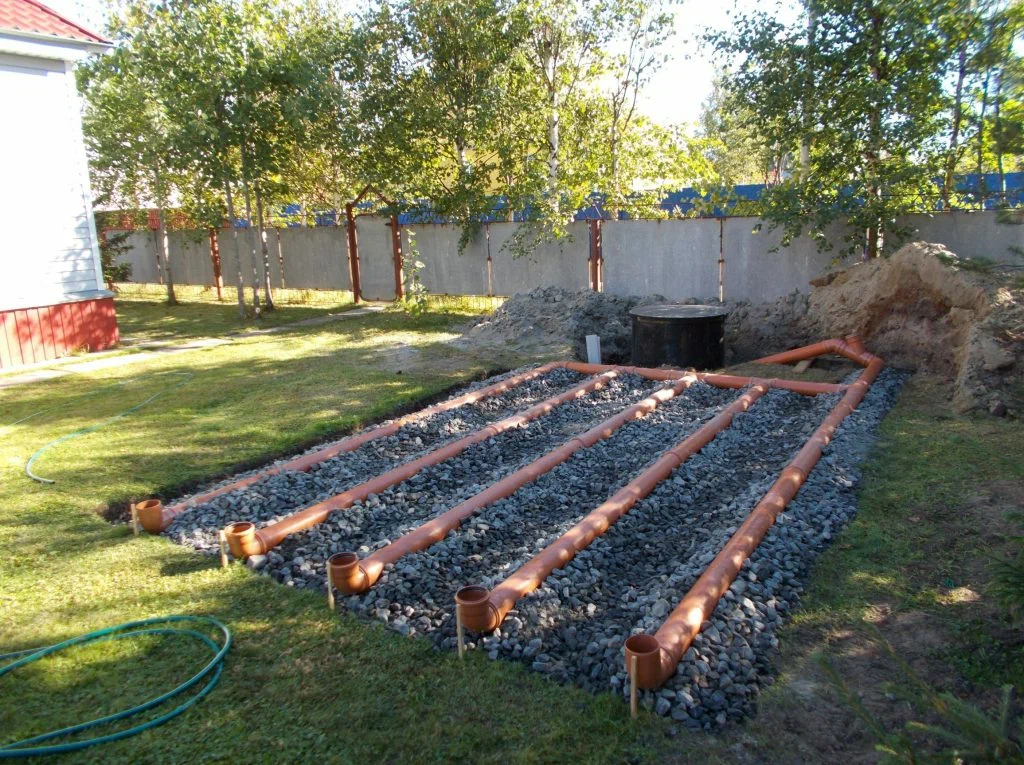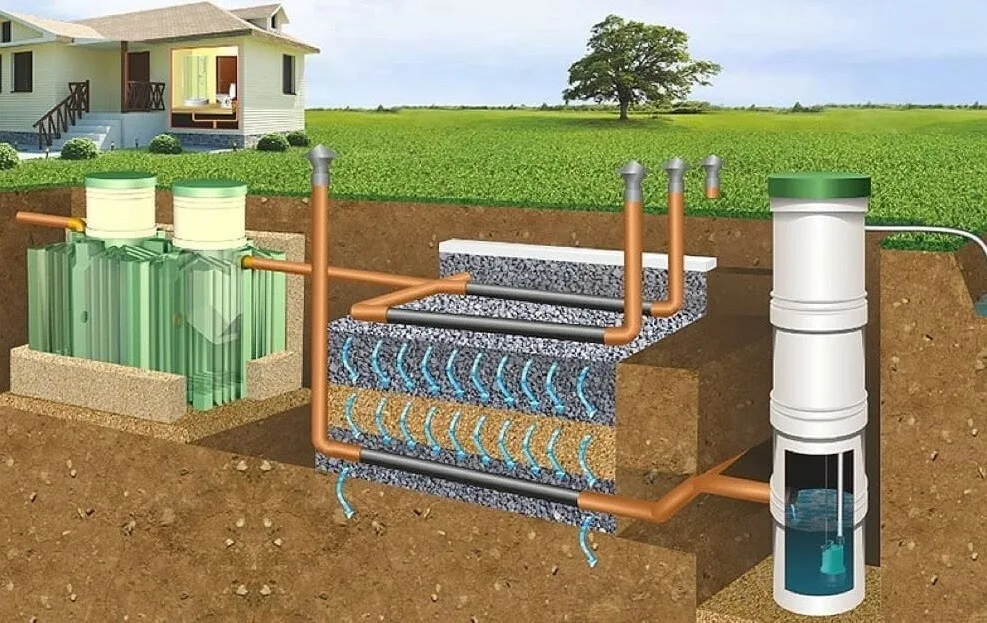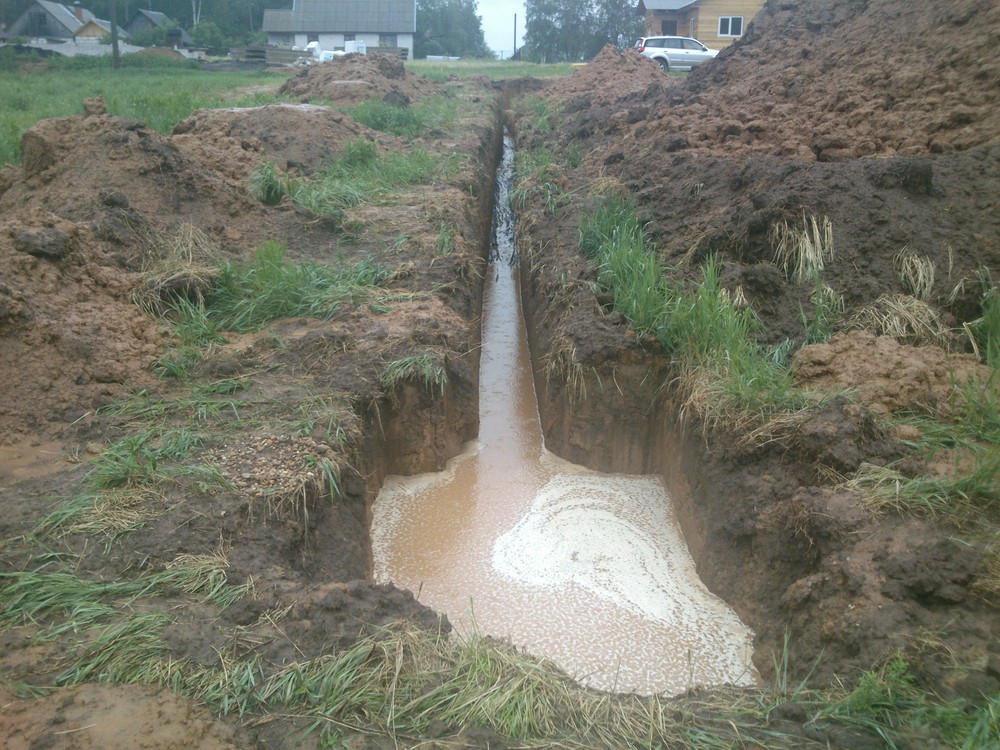1. Clogging of the system
Septic tank clogging is one of the most common problems that can lead to serious consequences if not addressed in a timely manner. The main function of a septic tank is to separate solid waste from liquids, where the solid waste settles to the bottom and the treated water is gradually drained to a drain field. If non-biodegradable materials (e.g., paper towels, napkins, plastic), fats or oils enter the system, it can lead to a buildup of waste that clogs pipes or the drainage system.
Signs of a clog:
- Slow drainage in sinks, showers and toilets.
- Water can back up back into the house, especially when using plumbing fixtures.
- There is an unpleasant odor in the house or on the property near the septic tank.
How to prevent:
- Do not dump non-biodegradable materials into the septic tank.
- Avoid dumping fats and oils, as they harden and form deposits over time.
- Perform regular preventive cleaning of the septic tank and drainage system.
2. Tank overfilling
A septic tank is designed to collect and process wastewater, but if its tank fills too quickly or is not cleaned in a timely manner, it can overflow. Overfilling occurs when wastewater does not have enough time to be cleaned and go into the drainfield, and the tank can no longer handle the volume of liquid.
Signs of overflow:
- Wastewater comes to the soil surface.
- Flooded or wet areas on the property are formed.
- Unpleasant odors from the sewage may appear in the home.
- Drainage in the home slows down or stops.
How to prevent:
- Have your septic tank cleaned regularly (usually every 3 to 5 years, depending on volume and usage).
- Reduce the load on the system by avoiding excessive water usage (for example, don’t run the washing machine and dishwasher at the same time).
- Check the condition of the drain field.
3. Damage to the drain field
The drainfield plays a key role in the septic tank system, as it is responsible for carrying treated wastewater back to the soil. If the drainfield becomes damaged, it can cause water to not effectively soak into the soil, leading to flooding of the area and disruption of the entire system.

Signs of damage:
- Persistently wet or flooded areas on the property, even in dry weather.
- Sensation of a foul odor in the vicinity of the drainfield.
- Slow or no outflow of water in the system.
Causes of damage:
- Tree roots can penetrate and disrupt drainage pipes.
- Heavy equipment or vehicles driving over the field can damage the pipes.
- Improper installation or soil erosion can also cause malfunctions.
How to prevent:
- Avoid planting trees and large shrubs near the drainfield.
- Do not use the drainfield as a parking lot or a place to store heavy objects.
- Check the condition of the drainfield regularly and perform preventive maintenance.
4. Clogged or broken vents
Septic tanks are equipped with vents to prevent gas buildup and maintain proper system pressure. If these vents become clogged or damaged, it can disrupt air circulation and cause the septic tank to malfunction.

Signs of a clogged vent:
- Unpleasant odors in the house or on the property.
- Water draining slowly in plumbing fixtures.
- In some cases, there may be a “gurgling” sound in the pipes.
Causes of clogging:
- Debris, leaves or other organic material getting into the vents.
- Damage to the covers or the vent system itself.
How to prevent:
- Install protective screens over the vents.
- Check the vents regularly to make sure they are not clogged.
- Perform preventive cleaning of the vents.
5. Pump malfunction
Many septic tanks are equipped with pumps to pump wastewater to a tank or drain field. Pumps can fail due to wear, overloading, or improper connection. If the pump stops working, wastewater will not be able to drain properly, causing the system to overflow.
Signs of pump failure:
- The wastewater level in the septic tank does not drop after pumping.
- The alarm system (if present) indicates a pump failure.
- Water is not leaving the tank.
How to prevent:
- Check the pump and its connections regularly.
- Do not overload the system with wastewater.
- Make sure the pump is replaced or repaired in a timely manner.
6. Tank Leakage
The septic tank must be sealed to prevent wastewater from leaking into the ground and to prevent environmental pollution. Over time, due to mechanical damage or corrosion, the tank may lose its tightness.

Signs of depressurization:
- Appearance of wet areas or leaks around the septic tank.
- Unpleasant odors in the vicinity of the septic tank.
- Uneven water levels in the tank, which may indicate leaks.
Causes:
- Physical damage to the tank (such as from tree roots or heavy machinery).
- Wear and tear on the material the tank is made of, especially if it is metal or concrete construction.
How to prevent:
- Avoid damaging the septic tank with heavy objects.
- Inspect the tank regularly for cracks or corrosion.
- Use high quality materials when installing the septic tank.
7. Improper functioning of the bacteria
The balance of microorganisms that decompose organic matter is important for the proper functioning of the septic tank. If harsh chemicals such as bleach, antibacterial agents, or other strong detergents are introduced into the system, it can disrupt the microflora, leading to a buildup of waste.
Signs of microflora disruption:
- Slow processing of wastewater.
- Rapid accumulation of solid sludge in the tank.
- Appearance of unpleasant odors.
How to prevent:
- Avoid the use of harsh chemicals.
- Periodically add special biopreparations to restore bacterial activity.
- Monitor the balance of liquid and solid waste.
8. Groundwater infiltration
A high water table can put pressure on the septic tank system, which can cause it to overflow or become damaged. Groundwater can penetrate the tank through cracks or joints, reducing its efficiency and leading to leaks.

Signs of groundwater infiltration:
- A consistently high water level in the septic tank, even during normal use.
- Overfilling of the tank for no apparent reason.
- Flooding or dampness around the system.
How to prevent:
- Make sure the septic tank is installed at a safe depth, away from bodies of water.
- Use tank waterproofing to protect against groundwater infiltration.
- Conduct regular inspections of the system, especially during periods of rain or snowmelt.
9. Problems with the electrical system
Modern septic tanks are often equipped with electrical components such as pumps, control systems, and water level sensors. These elements help automate processes and ensure that the system operates efficiently. However, like any electronics, they can malfunction for a number of reasons.
Causes of failure:
- Equipment wear and tear. Over time, pumps and other electrical components can wear out and stop functioning properly. Frequent starts and stops and mechanical stress accelerate this process.
- Short circuits or blown fuses. Septic tank electrical systems can encounter short circuits due to moisture, damaged wiring, or component failure, which can cause fuses to blow.
- Sensor malfunctions. Water level sensors or alarms may stop working properly due to contamination, damage, or electrical circuit failure.
- Improper installation. Errors in wiring installation, inadequate moisture protection, or lack of grounding may cause electrical system malfunctions.
Signs of malfunctions:
- Pump does not run. If the pump does not start, it may indicate a problem with the electrical supply or with the unit itself. This can cause the tank to overflow and sewage to come to the surface.
- Alarms. Modern systems are often equipped with alarms that go off when problems occur. If the alarm goes off frequently or does not go off, this is a clear sign of trouble.
- Malfunctions in other components. For example, if water level sensors are malfunctioning, the system may not properly regulate wastewater pumping, causing the tank to overflow.
How to troubleshoot:
- Check the power supply. First, make sure the septic tank is receiving power. This can be checked by inspecting the condition of the wires, outlets, and fuses. If there are signs of corrosion or damage, you need to replace the components.
- Cleaning the sensors. If the problem is due to incorrect data from the sensors, they should be inspected and cleaned of contaminants if necessary.
- Replacing failed components. If the pump or other electrical components are worn out, they should be replaced with new ones. It is recommended to contact specialists to install new parts and check the system.
- Professional diagnostics. If the problem is complex or cannot be determined by yourself, it is worth calling a professional who will check the entire electrical system, identify the fault and make repairs.
Prevention:
- Regular maintenance. Periodic inspection of your septic tank’s electrical systems will help avoid sudden breakdowns. It is recommended that the system be inspected at least once a year.
- Installation of surge protection systems. To avoid damage to the equipment during power surges, it is recommended to install protection devices such as stabilizers.
- Protection against moisture. Electrical components should be reliably insulated from moisture, which is especially important for underground septic tanks.